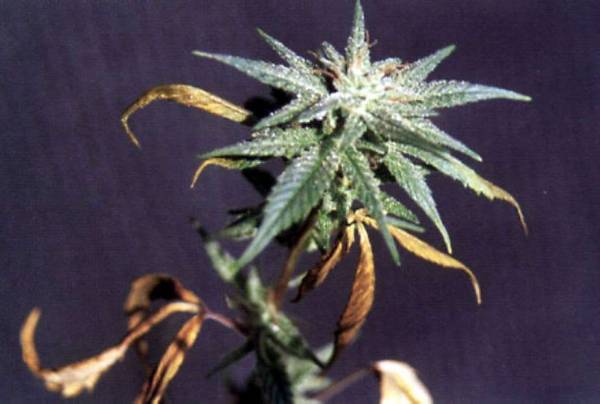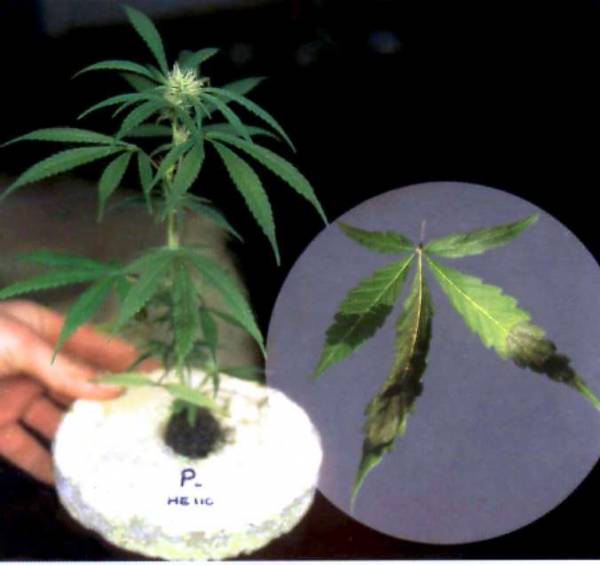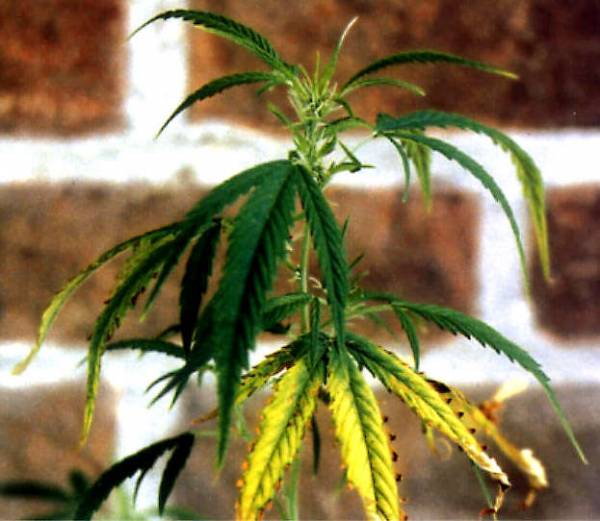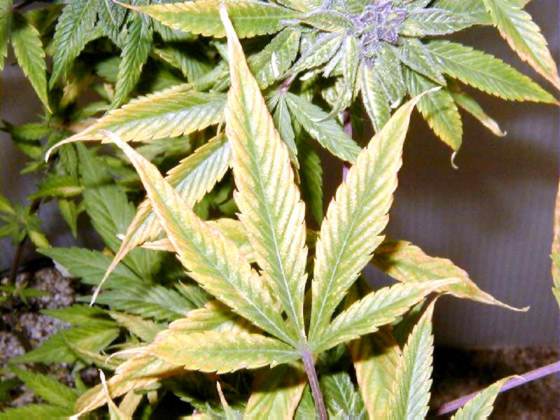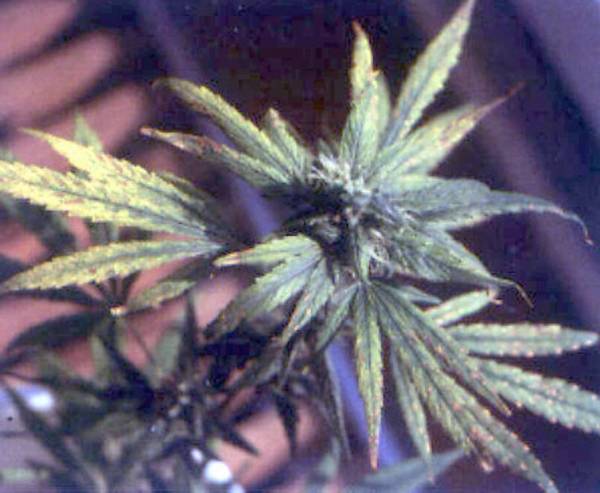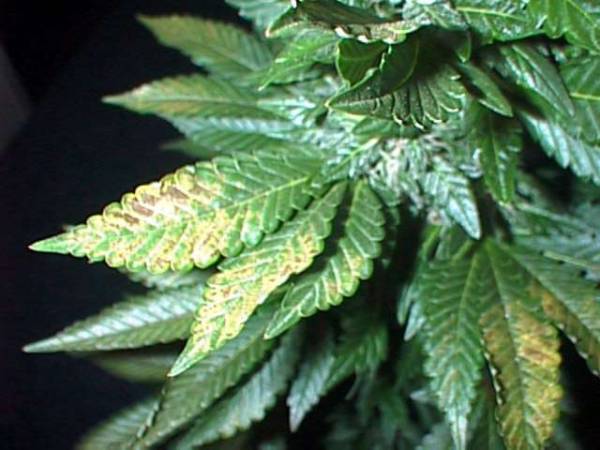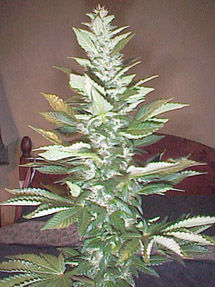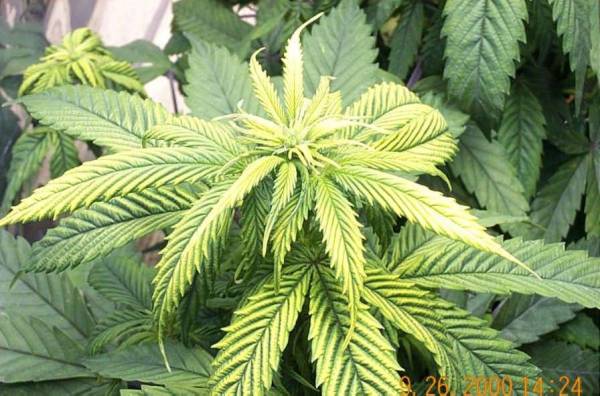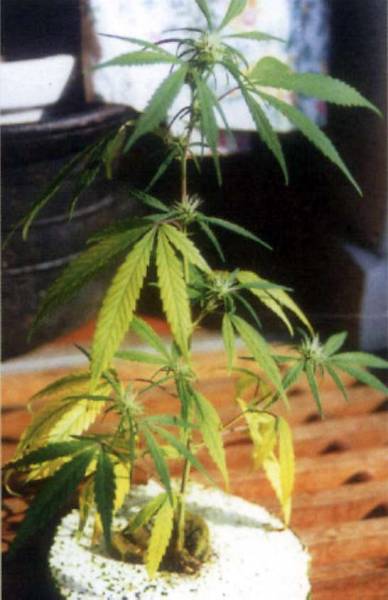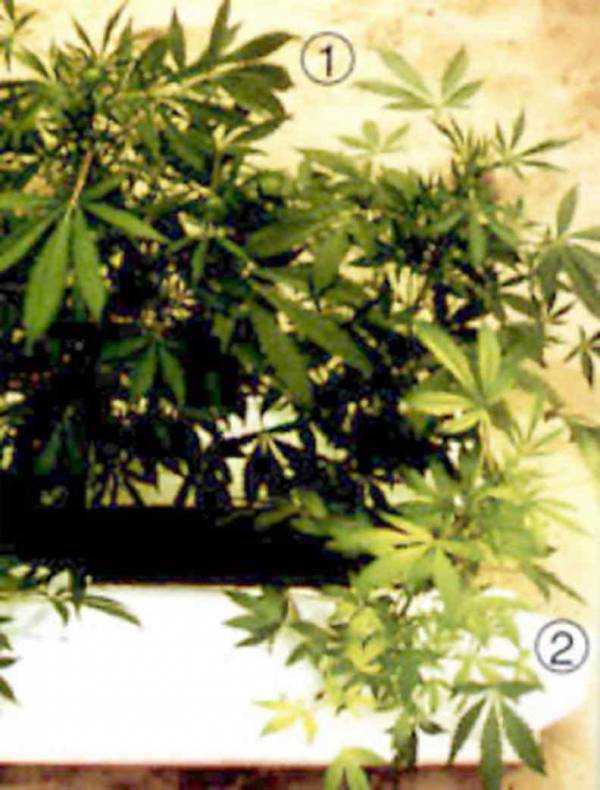Akornpatch
Well-Known Member
Heat Stress
Look closely, and you'll see the brown leaf edges that are indicative of heat stress. This damage looks a lot like nutrient burn, except it occurs only at the tops of the plants closest to the lamps. There's only one cure for this...get the heat away from the plants, either by moving the lamps or moving the plants.
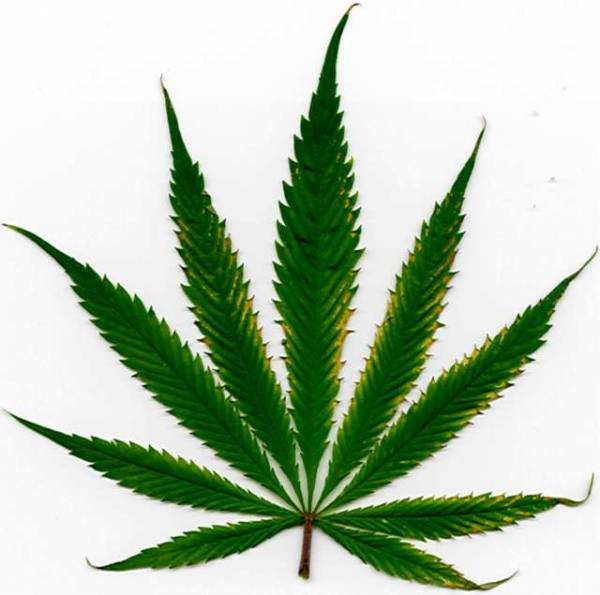
Figure 1
Nutrient Solution Burn
There's a good chance that this bud was subjected to nutrient solution burn. These symptoms are seen when the EC concentration of hydroponic solutions is too high. These symptoms also appear when strong nutrient solution is splashed onto the leaves under hot HID lamps, causing the leaves to burn under the solution.
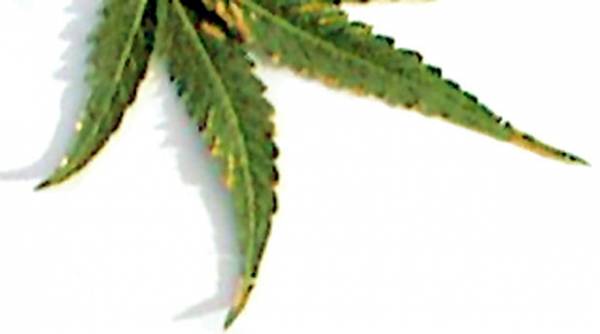
Figure 2
Many hydroponic gardeners see this problem. It's the beginning of nutrient burn. It indicates that the plants have all the nutrients they can possibly use, and there's a slight excess. Back off the concentration of the nutrient solution just a touch, and the problem should disappear. Note that if the plants never get any worse than this here, then the plants are probably just fine.
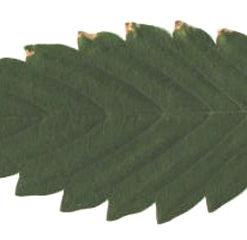
Figure 3
Figure 4 is definitely an over-fertilization problem. The high level of nutrients accumulates in the leaves and causes them to dry out and burn up as shown here. You must flush with clear, clean water immediately to allow the roots to recover, and prevent further damage. The find the cause of the high nutrient levels.
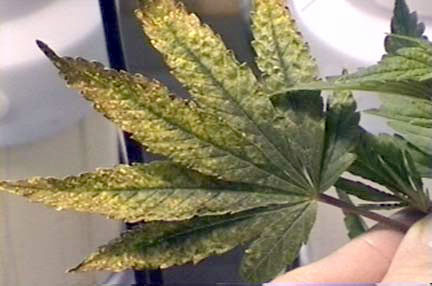
Figure 4
Over Watering
The plants in Figure 1 were on a continuous drip system, where nutrient solution is constantly being pumped into the medium. This tends to keep the entire root system completely saturated. A better way would be to periodically feed the plants, say for 1/2 hour every 2-3 hours. This would give the roots a chance to get needed air to them, and prevent root rot and other problems.
Don't be throw off by the fact that the plants in Figure 5 are sitting in still water, this is actually an H2O2 solution used to try and correct the problem. Adding an air stone to the tub would also help add O2 to the solution.
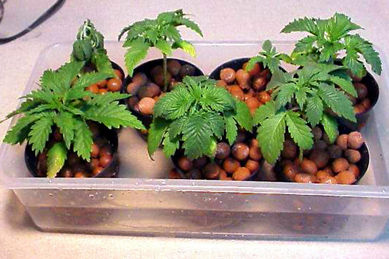
Figure 5
pH Fluctuation
Both of these leaves in figure 6 and figure 7 are from the same plant. It could be over fertilization, but more likely it is due to the pH being off. Too high or too low a pH can lock up nutrients in the form of salts and compounds, some of which are actually toxic to the plants. What then happens is the grower then tries to supplement the plants diet by adding more fertilizers, throwing off the pH even more and locking up even more nutrients. This type of problem is seen more often in soil mixes, where inconsistent mixing of the medium's components leads to "hot" spots.
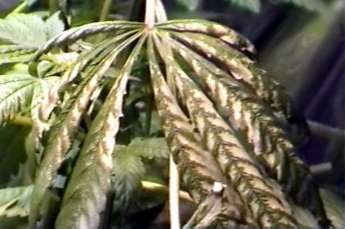
Figure 6
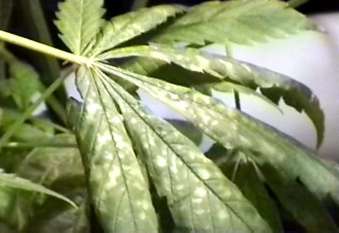
Figure 7
Ozone damage
Ozone damage is typically found near the generator. Although a rare problem, symptoms generally appear as a Mg deficiency, but the symptoms are localized to immediately around the generator.
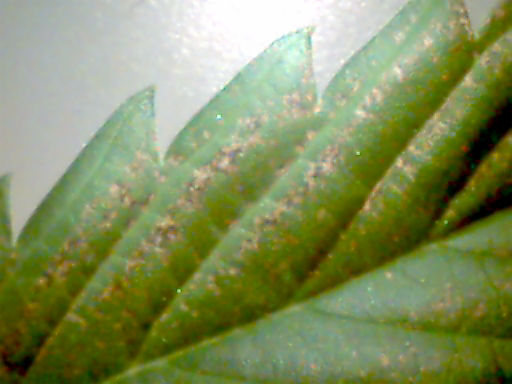
Figure 8
NUTRIENT PROBLEMS
Root stunting
Root stunting is characteristic of calcium deficiency, acidity, aluminum toxicity, and copper toxicity. Some species may also show it when boron deficient. The shortened roots become thickened, the laterals become stubby, peg-like, and the whole system often discolors, brown or gray.
Symptoms localized at shoot growing points.
New shoots unopened; young leaves distorted; dead leaf tips; pale green plant copper deficiency
New shoots withered or dead; petiole or stem collapse; shoots stunted; green plant calcium deficiency
Young leaves pale green or yellow; rosetting or dead tip; die back; dark green plant boron deficiency
MOBILE ELEMENTS
Mobile elements are more likely to exhibit visual deficiencies in the older leaves, because during demand these elements will be exported to the new growth.
Nitrogen (N)
Nitrate - Ammonium is found in both inorganic and organic forms in the plant, and combines with carbon, hydrogen, oxygen and sometimes sulfur to form amino acids, amino enzymes, nucleic acids, chlorophyll, alkaloids, and purine bases. Nitrogen rates high as molecular weight proteins in plant tissue.
Plants need lots of N during vegging, but it's easy to overdo it. Added too much? Flush the soil with plain water. Soluble nitrogen (especially nitrate) is the form that's the most quickly available to the roots, while insoluble N (like urea) first needs to be broken down by microbes in the soil before the roots can absorb it. Avoid excessive ammonium nitrogen, which can interfere with other nutrients.
Too much N delays flowering. Plants should be allowed to become N-deficient late in flowering for best flavor.
Nitrogen Deficiencies
Plants will exhibit lack of vigor, slow growth and will be weak and stunted. Quality and yield will be significantly reduced. Older leaves become yellow from lack of chlorophyll. Deficient plants will exhibit uniform light green to yellow on older leaves, these leaves may die and drop. Leaf margins will not curled up noticeably. Chlorosis will eventually spread throughout the plant. Stems, petioles and lower leaf surfaces may turn purple.
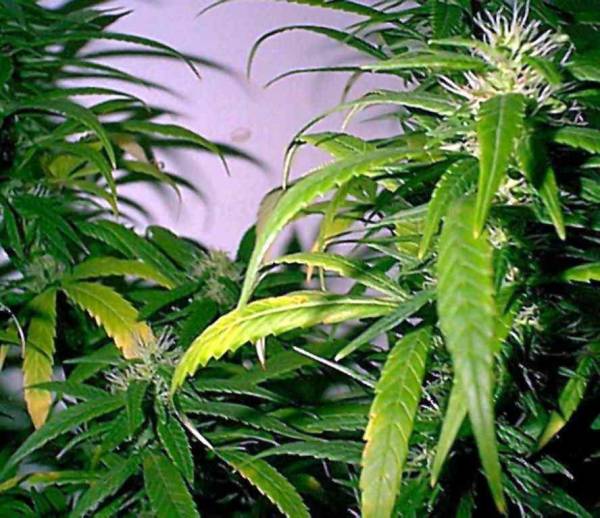
Figure 9
As seen in figure 10 consumption of nitrogen (N) from the fan leaves during the final phase of flowering is 100% normal.
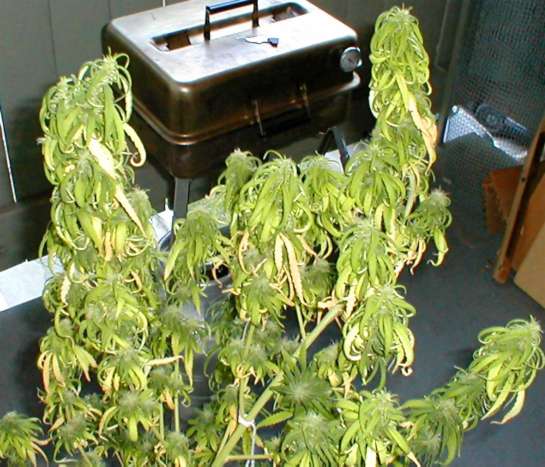
Figure 10
Look closely, and you'll see the brown leaf edges that are indicative of heat stress. This damage looks a lot like nutrient burn, except it occurs only at the tops of the plants closest to the lamps. There's only one cure for this...get the heat away from the plants, either by moving the lamps or moving the plants.

Figure 1
Nutrient Solution Burn
There's a good chance that this bud was subjected to nutrient solution burn. These symptoms are seen when the EC concentration of hydroponic solutions is too high. These symptoms also appear when strong nutrient solution is splashed onto the leaves under hot HID lamps, causing the leaves to burn under the solution.

Figure 2
Many hydroponic gardeners see this problem. It's the beginning of nutrient burn. It indicates that the plants have all the nutrients they can possibly use, and there's a slight excess. Back off the concentration of the nutrient solution just a touch, and the problem should disappear. Note that if the plants never get any worse than this here, then the plants are probably just fine.

Figure 3
Figure 4 is definitely an over-fertilization problem. The high level of nutrients accumulates in the leaves and causes them to dry out and burn up as shown here. You must flush with clear, clean water immediately to allow the roots to recover, and prevent further damage. The find the cause of the high nutrient levels.

Figure 4
Over Watering
The plants in Figure 1 were on a continuous drip system, where nutrient solution is constantly being pumped into the medium. This tends to keep the entire root system completely saturated. A better way would be to periodically feed the plants, say for 1/2 hour every 2-3 hours. This would give the roots a chance to get needed air to them, and prevent root rot and other problems.
Don't be throw off by the fact that the plants in Figure 5 are sitting in still water, this is actually an H2O2 solution used to try and correct the problem. Adding an air stone to the tub would also help add O2 to the solution.

Figure 5
pH Fluctuation
Both of these leaves in figure 6 and figure 7 are from the same plant. It could be over fertilization, but more likely it is due to the pH being off. Too high or too low a pH can lock up nutrients in the form of salts and compounds, some of which are actually toxic to the plants. What then happens is the grower then tries to supplement the plants diet by adding more fertilizers, throwing off the pH even more and locking up even more nutrients. This type of problem is seen more often in soil mixes, where inconsistent mixing of the medium's components leads to "hot" spots.

Figure 6

Figure 7
Ozone damage
Ozone damage is typically found near the generator. Although a rare problem, symptoms generally appear as a Mg deficiency, but the symptoms are localized to immediately around the generator.

Figure 8
NUTRIENT PROBLEMS
Root stunting
Root stunting is characteristic of calcium deficiency, acidity, aluminum toxicity, and copper toxicity. Some species may also show it when boron deficient. The shortened roots become thickened, the laterals become stubby, peg-like, and the whole system often discolors, brown or gray.
Symptoms localized at shoot growing points.
New shoots unopened; young leaves distorted; dead leaf tips; pale green plant copper deficiency
New shoots withered or dead; petiole or stem collapse; shoots stunted; green plant calcium deficiency
Young leaves pale green or yellow; rosetting or dead tip; die back; dark green plant boron deficiency
MOBILE ELEMENTS
Mobile elements are more likely to exhibit visual deficiencies in the older leaves, because during demand these elements will be exported to the new growth.
Nitrogen (N)
Nitrate - Ammonium is found in both inorganic and organic forms in the plant, and combines with carbon, hydrogen, oxygen and sometimes sulfur to form amino acids, amino enzymes, nucleic acids, chlorophyll, alkaloids, and purine bases. Nitrogen rates high as molecular weight proteins in plant tissue.
Plants need lots of N during vegging, but it's easy to overdo it. Added too much? Flush the soil with plain water. Soluble nitrogen (especially nitrate) is the form that's the most quickly available to the roots, while insoluble N (like urea) first needs to be broken down by microbes in the soil before the roots can absorb it. Avoid excessive ammonium nitrogen, which can interfere with other nutrients.
Too much N delays flowering. Plants should be allowed to become N-deficient late in flowering for best flavor.
Nitrogen Deficiencies
Plants will exhibit lack of vigor, slow growth and will be weak and stunted. Quality and yield will be significantly reduced. Older leaves become yellow from lack of chlorophyll. Deficient plants will exhibit uniform light green to yellow on older leaves, these leaves may die and drop. Leaf margins will not curled up noticeably. Chlorosis will eventually spread throughout the plant. Stems, petioles and lower leaf surfaces may turn purple.

Figure 9
As seen in figure 10 consumption of nitrogen (N) from the fan leaves during the final phase of flowering is 100% normal.

Figure 10



